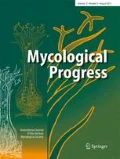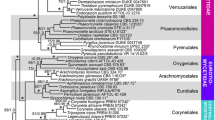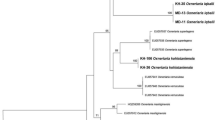Abstract
Three new species, closely related to Sphaerostilbella broomeana, are described from the USA and India. These species form septate conidia from simple conidiophores with individual branches terminating in a single phialide and chlamydospores. Teleomorphs, known for S. broomeana and S. appalachiensis, are characterised by hairy perithecia and fusiform, apiculate, and conspicuously warted ascospores. This combination of characters distinguishes the S. broomeana-group from other members of Sphaerostilbella that all form gliocladium-type anamorphs and mostly grow on basidiomata of Stereum spp. Like in other species of the genus, the majority of hosts of the species described in this paper belong to wood-inhabiting taxa of Russulales. Sphaerostilbella broomeana had been recorded from a few regions in Europe and exclusively on Heterobasidion annosum. Herein, it is reported also from H. parviporum in many other localities and on H. insulare s.l. at the foothills of the Himalayas. Its sister species, found in the same region in northern India on another member of Russulales (Dichostereum effuscatum), is described as S. himalayensis. The two species described from North America colonize polypores from various taxa. Whereas S. appalachiensis occurs in eastern USA, with H. irregulare among its hosts, S. toxica is so far known only from two locations in eastern Texas, growing on Gloeophyllum striatum (Polyporales). Despite their great similarity in morphology and ITS rDNA, TEF1 sequences clearly distinguish these two North-American species. Moreover, the two strains of S. toxica appeared metabolically distinct as their organic extracts strongly inhibited the growth of human pathogenic microbes grown in vitro. Phylogenetic analysis of rDNA sequences supports monophyly of the genus Sphaerostilbella and the included S. broomeana-group, established here.





Similar content being viewed by others
References
Arnold G (1963) Einige seltene Pilze auf Hymenomyceten. Z Pilzk 29:33–36
Arnold G (1970) Über Hypomyces porotheliiformis und seine Nebenfruchtform. Westfälische Pilzbriefe 8:11–13
Candoussau F, Magni J-F (1995) New French records. Mycologist 9(1):12–14
Carbone I, Kohn LM (1999) A method for designing primer sets for speciation studies in filamentous ascomycetes. Mycologia 91:553–556
Gams W, van Zaayen A (1982) Contribution to the taxonomy and pathogenicity of fungicolous Verticillium species I: taxonomy. Neth J Plant Pathol 88:57–78
Helfer W (1991) Pilze auf Pilzfruchtkörpern. Untersuchungen zur Ökologie, Systematik und Chemie. Libri Botanici 1:1–157
Jaklitsch WM, Komon M, Kubicek CP, Druzhinina IS (2005) Hypocrea voglmayrii sp. nov. from the Austrian Alps represents a new phylogenetic clade in Hypocrea/Trichoderma. Mycologia 97(6):1365–1378. https://doi.org/10.1080/15572536.2006.11832743
Jaklitsch WM, Põldmaa K, Samuels (2008) Reconsideration of Protocrea (Hypocreales, Hypocreaceae). Mycologia 100:962–984
Katoh K, Standley DM (2013) MAFFT multiple sequence alignment software version 7: improvements in performance and usability. Mol Biol Evol 30:772–780
Kõljalg U, Nilsson RH, Abarenkov K, Tedersoo L, Taylor AFS, Bahram M, Bates ST, Bruns TD, Bengtsson-Palme J, Callaghan TM, Douglas B, Drenkhan T, Eberhardt U, Dueñas M, Grebenc T, Griffith GW, Hartmann M, Kirk PM, Kohout P, Larsson E, Lindahl BD, Lücking R, Martín MP, Matheny PB, Nguyen NH, Niskanen T, Oja J, Peay KG, Peintner U, Peterson M, Põldmaa K, Saag L, Saar I, Schüßler A, Scott JA, Senés C, Smith ME, Suija A, Taylor DL, Telleria MT, Weiß M, Larsson K-H (2013) Towards a unified paradigm for sequence-based identification of fungi. Molecular Ecology, doi: https://doi.org/10.1111/mec.12481
Larsson A (2014) AliView: a fast and lightweight alignment viewer and editor for large data sets. Bioinformatics 30(22):3276–3278. https://doi.org/10.1093/bioinformatics/btu531
O’Donnell K, Kistler HC, Cigelnik E, Ploetz RC (1998) Multiple evolutionary origins of the fungus causing Panama disease of banana: concordant evidence from nuclear and mitochondrial gene genealogies. Proc Natl Acad Sci U S A 95:2044–2049. https://doi.org/10.1073/pnas.95.5.2044
Põldmaa K (1999) The genus Hypomyces and allied fungicolous fungi in Estonia. I. Species growing on aphyllophoralean basidiomycetes. Folia Cryptogamica Estonica 34:15–31
Põldmaa K (2000) Generic delimitation of fungicolous Hypocreaceae. Stud Mycol 45:83–94
Põldmaa K (2011) Tropical species of Cladobotryum and Hypomyces producing red pigments. Stud Mycol 68:1–34. 1e34. https://doi.org/10.3114/sim.2011.68.01
Põldmaa K, Larsson E, Kõljalg U (1999) Phylogenetic relationships in Hypomyces and allied genera, with emphasis on species growing on wood-decaying homobasidiomycetes. Can J Bot 77:1756–1767
Põldmaa K, Samuels GJ, Lodge DJ (1997) Three new polyporicolous species of Hypomyces and their Cladobotryum anamorphs. Sydowia 49:80–93
Põldmaa K, Samuels GJ (1999) Aphyllophoricolous species of Hypomyces with KOH-negative perithecia. Mycologia 91:177–199
Rehner SA (2001) Primers for Elongation Factor 1-alpha (EF1-alpha). http://www.aftol.org/pdfs/EF1primer.pdf
Rogerson CT, Samuels GJ (1993) Polyporicolous species of Hypomyces. Mycologia 85:231–272
Ronquist F, Teslenko M, van der Mark P, Ayres DL, Darling A, Höhna S, Larget B, Liu L, Suchard MA, Huelsenbeck JP (2012) MrBayes 3.2: efficient Bayesian phylogenetic inference and model choice across a large model space. Syst Biol 61(3):539–542
Seifert KA (1985) A monograph of Stilbella and some allied Hyphomycetes. Stud Mycol 27:1–235
Stamatakis A (2014) RAxML version 8: a tool for phylogenetic analysis and post-analysis of large phylogenies. Bioinformatics 30:1312–1313
Tedersoo L, Jairus T, Horton BM, Abarenkov A, Suvi T, Saar I, Kõljalg U (2008) Strong host preference of ectomycorrhizal fungi in a Tasmanian wet sclerophyll forest as revealed by DNA barcoding and taxon-specific primers. New Phytol 180:479–490. https://doi.org/10.1111/j.1469-8137.2008.02561.x
Tulasne LR, Tulasne C (1865) Selecta fungorum carpologia 3. Jusseau, Paris
Vilgalys R, Hester M (1990) Rapid genetic identification and mapping of enzymatically amplified ribosomal DNA from several Cryptococcus species. J Bacteriol 172:4238–4246
White TJ, Bruns TD, Lee S, Taylor JW (1990) Amplification and direct sequencing of fungal ribosomal RNA genes for phylogenetics. In: Innis MA, Gelfand H, Sninsky JS, White TJ (eds) PCR protocols: a guide to methods and applications. Academic Press, San Diego, pp 315–322
Zare R, Gams W (2016) More white verticillium-like anamorphs with erect conidiophores. Mycol Prog 15:993–1030. https://doi.org/10.1007/s11557-016-1214-8
Acknowledgements
KP and GB are grateful to the late Walter Gams for all his help and guidance in the world of conidial fungi, for sending and commenting on many isolates, and assistance with editing manuscripts. Thanks are also due to Jacques Fournier, Leif Ryvarden, and Oleksandr Akulov for providing specimens for this study and to Vjacheslav Spirin, who checked or provided identifications and discussion on the characters of the hosts. We are grateful to Irma Zettur and Rasmus Puusepp (University of Tartu) for the assistance in the fungal culture and molecular lab, respectively. Two reviewers and the section editor, in particular, are acknowledged for revising the manuscript.
Funding
The study was supported by the Estonian Science Agency (project IUT20-30) and the European Regional Development Fund (Centre of Excellence EcolChange). GB has been supported by University of Texas Health Science Center at Houston new faculty start-up funds, the Kay and Ben Fortson Endowment, and a grant from the NIH (R01GM121458).
Author information
Authors and Affiliations
Corresponding author
Additional information
Section Editor: Hans-Josef Schroers
Publisher’s Note
Springer Nature remains neutral with regard to jurisdictional claims in published maps and institutional affiliations.
This article is part of the “Special Issue on hyphomycete taxonomy and diversity in honour of Walter Gams who passed away in April 2017”.
Electronic supplementary material
ESM 1
(PDF 98.9 kb)
Rights and permissions
About this article
Cite this article
Põldmaa, K., Bills, G., Lewis, D.P. et al. Taxonomy of the Sphaerostilbella broomeana-group (Hypocreales, Ascomycota). Mycol Progress 18, 77–89 (2019). https://doi.org/10.1007/s11557-018-01468-w
Received:
Revised:
Accepted:
Published:
Issue Date:
DOI: https://doi.org/10.1007/s11557-018-01468-w




